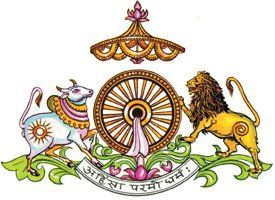
Ahiṃsā paramo dharmaḥ
The word is derived from the Sanskrit root hims - to strike; hinsa is injury or harm, a-hinsa is the opposite of this, i.e. non harming or nonviolence.Symbol:
[ In fact: the root law of all religions given for the benefit of mankind ] Literally: the avoidance of violence
Meaning:
Ahimsa is first vow of the mahavrats (great vows)
- Transmutation Of Personality [17] Right Background For Meditation - Acharya Ganadhipati Tulsi
The practice of non-violence means freedom from attachment and aversion; its fruition is the feeling of goodwill towards the whole world. Freedom from attachment and aversion leads to veetaragta (freedom from affections and passions), and the feeling of goodwill leads to identification with the soul of the world. In so far as the realisation of veetaragta and the feeling of goodwill increase the purity of the mind, the state of meditation is equally strengthened.The complementary principle of Ahimsa is Anekant. Fearlessness is the core of all religions. Ahimsa, the message of fearlessness, was given again by Lord Mahavira: "Fear None" - "One who is not fearless cannot be a votary of ahimsa, truth, celibacy, non-covetousness, etc."
It was highly respected throughout the centuries by Hindus and Buddhists as well.In Jainism, Ahimsa is the standard by which all actions are judged.In 20th century, Mahatma Gandhi, the famous politician, philosopher and spiritual leader, was inspired by the principle of Ahimsa to develop his theory of passive resistance as a means of bringing about political change.
See also:
- Albert Schweitzer's "reverence for life", based on ahimsa.
- Veganism, fastest growing ethical movement in the world, based on ahimsa.
Male and female lay members of the Sangh observe 5 small vows (Anuvrata), on the base of Ahimsa meaning for them not to kill any life.The attributes of Ahimsa:
Male and female ascetics observe the much more severe great vows (Mahavrats), which are also based on the principle of Ahimsa. For them, Ahimsa entails the greatest care to prevent them from knowingly or unknowingly being the cause of injury or harm to any kind of life.'Any kind of life' includes not only human beings and animals but insects, plants, and atoms as well.Many common Jain practices, such as not eating or drinking after dark or the wearing of mouth covers (Mukhavastrika) by monks and nuns, are based on the principle of Ahimsa.
- fearlessness (fear none, nor yourself, nor old age, nor deseases, nor death)
- restraint (of senses, mind, consumption)
- equanimity (staying cool in good and bad)
- peace (the absence of violence, deliverance from tension)
- compassion (compassionate and amiable behaviour with others)
